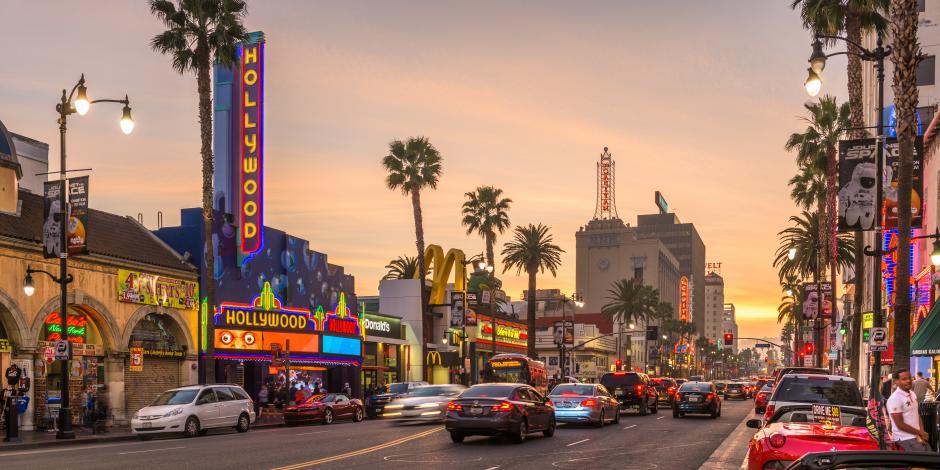Starten Sie den Audio-Text
Mit dem Audio-Player können Sie sich den Text anhören. Darunter finden Sie das Transkript.
Are you curious to find out how the movie industry is changing? Business Spotlight spoke to two L.A.-based industry professionals. In the following interview extracts, you will hear writer, directorhier: Regisseur(in)director and producer Michael Sucsy, who works mostly in film and television, and producer Marie Dunaway, who primarily works on commercialWerbespotcommercials, talking about some of the developments they have witnessed in the industry. In the interview extracts, you will hear some references to “the strikes,” which are the Screen Actors Guild (SAG)US-amerikanische SchauspielergewerkschaftScreen Actors Guild — American Federation of Television and Radio Artists (also known as SAG-AFTRA) strikes that took place in 2023. First, you’ll hear both interviewees reflecting on what has changed in the movie business in recent years.
Michael: I think that AI is the least of it. I mean it’s really been the fundamental shifthier: Veränderungshift in the business model, which has been bring sth. onetw. hervorrufen, verursachenbrought on by streaming. The secondary factor would be, and it’s related to the primary one, is the shift in people’s theatricalhier: Kinotheatrical habits in terms of going out to the movies. With streaming, there’s, you know, much more that’s available to them. And because of the pandemic, people got out of the habit of going to the theater and into the habit of being able to receive things, you know, at home. Anything that is release sth.etw. veröffentlichen, herausbringenreleased theatrically, the windowhier: Zeitfensterwindow to when it becomes available on some sort of a service, you know, has reduced, so all of those things have had [a] much stronger effect. And the strikes were really in response to that. AI came into the conversation when the strikes were already happening, so I am not downplaying that AI isn’t an important thing in our business, but it’s not the root cause of some of the issues that we’re having.
Marie: Technology is constantly evolving. And I believe when internet first came out, we were still learning a lot. And as the years progressed, it’s developed further and further into what we now see streamers doing. And even in the commercial/advertising space, the transition from broadcast to digital streaming or online commercial-making has increased significantly, where digital ads, I think, take up about 75 percent of the spend. So, it’s really become a very large market we have to pay attention to as the technology has evolved. And now, it’s like we still have to pay attention to how technology is evolving into AI, whereas maybe we’re not at an end product user stage, but we can’t, you know, pretend that things aren’t going to evolve further. We have to pay attention to where technology is taking us.
Then, Marie spoke about what has stayed the same in the industry despite the age of streaming.
Marie: What’s stayed the same? I would say the making of, you know, what we see on-screen is the same. It’s how we’re consuming and what, what screen we’re viewing [it] on. So, the process, the creative process of negotiating the script, and, you know, the cast, the locations, all that — that process is still the same. What we’re dealing with is format change and how we’re delivering content and how we’re consuming it. As viewers move from broadcast viewershipZuschauerschaft von Fernsehsendungenbroadcast to online viewership and from theaters to at-home streamers, we still have [a] cravingVerlangen, Gelüst(e)craving for both. As time goes on, it’s kind of hard to say what the landscape will be.
And Michael discussed the persisting problem, despite the better rates that were negotiated during the SAG-AFTRA strikes.
Michael: We’ve negotiated different rates, but the volume of work has, you know, recently depreciate to sth.auf etw. abfallendepreciated to a very, very low level. It’s not just the number of productions. It’s also the number of episodes per production. When we were talking about the broadcast model, you’re talking about usually about 22 episodes a season (US)hier: Staffelseason. And now, you’re talking about maybe six episodes a season. So, you can do the numbers right there. We’re paid per episode. When I say “we,” meaning creatives, you know, the writers, the directors, the actors, the producers; we’re paid per episode.
Neugierig auf mehr?
Dann nutzen Sie die Möglichkeit und stellen Sie sich Ihr optimales Abo ganz nach Ihren Wünschen zusammen.



